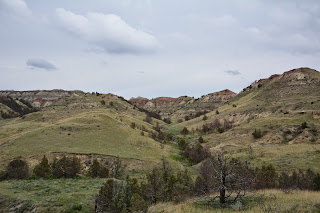That's it, hardly any romance here. And to think, less than 50 miles away are the badlands in Theodore Roosevelt National Park and the petrified wood!
There it is, South Killdeer Mountain.
Mr. Spock found it "fascinating", of course, and tried to generate some excitement around the geo-site, but, as you can see, he is making no headway with Frederick.
South Killdeer Mountain prominently crowned by caprock of Arikaree Formation.
What the geo-site did lead us to was an interesting historical site, Killdeer Mountain Battlefield. This site commemorates a battle fought on July 28, 1864, between troops commanded by General Sully and a gathering of several groups of the Dakota, Nakota, and Lakota (Sioux) Nations camped at this location. Major Sioux leaders included Medicine Bear and Sitting Bull. Sully's force had been sent into Dakota Territory to punish those who had participated in Minnesota's Dakota Conflict of 1862 as well as to develop routes to western gold fields. Many of the Sioux groups gathered at Killdeer Mountain had not participated in the Dakota conflict and had sought to make peace with the government.
Sully's force, equipped with several cannons, attacked and shelled the encampment, causing warriors, as well as unarmed men, women, and children, to flee into the Little Missouri badlands. Sully estimated between 100 and 150 Sioux were killed, but the exact number is unknown. His troops suffered five deaths. The Sioux lodges and all their winter supplies were destroyed by Sully's men.
The conflict a Killdeer Mountain further embittered relations between many Northern Plains tribes and the U.S. government.
On our trip out to Killdeer Mountain, called Tachawakute (The Place Where They Kill Deer) in the Nakota dialect, we also ran right into the middle of the conflict between the farmers/ranchers and the oilfields. The signs above read - No Oilfield Traffic.
The North Dakota economy is booming with oilfields and drilling. In the area we drove through today, oilfields line the highway and the few towns in the area are truly "booming", with development and building. But there is a lot of emotion on the part of the locals concerning property rights and the environment.
The location of the Battlefield site is on a man's farm where he is not sympathetic to big oil. This sign, on the gate to his farm, reads - Notice, No Hunting, Fishing, Hiking, Horseback riding, Metal Detecting. No Nothing, No Fooling. Without permission from the landowner.
Here's the gate with the sign - not exactly welcoming.
But it is a state historic site and we were able to drive, and stay only on the road, to the location.
The Monument at the battlefield site.
Two headstones honor soldiers killed in the conflict, Sergeant George Northrup, Company C, and Private Horace Austin, Company D, Brackett's Battalion, Minnesota Cavalry.
Adjacent roads list the names on the drilling sites.
A typical drilling site. If you look carefully at the first picture you can see a drilling site at the base of Killdeer Mountain, just at center right.
While we were in the area we drove over to the Little Missouri State Park which contains some the most rugged, picturesque Badlands terrain in the state. There we were, driving along the highway, and the oil fields, and all of a sudden the earth open up before us. Here are some pictures of what it looks like from inside the state park.
In this picture, and the ones below, you can see the thunderstorm and rain falling in the distance.



























































